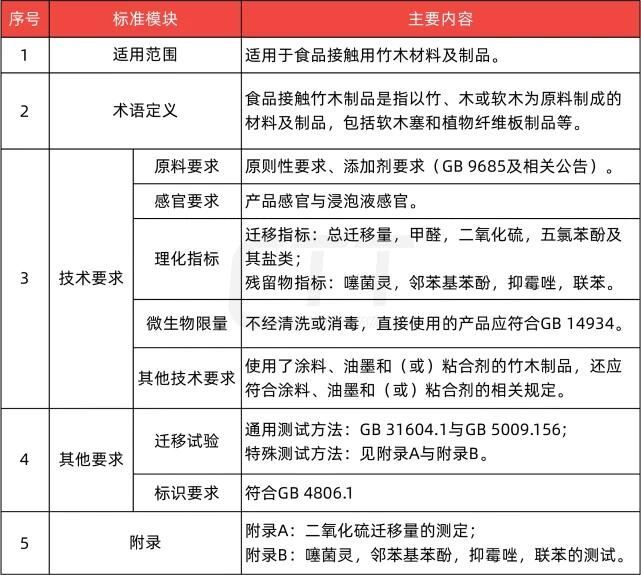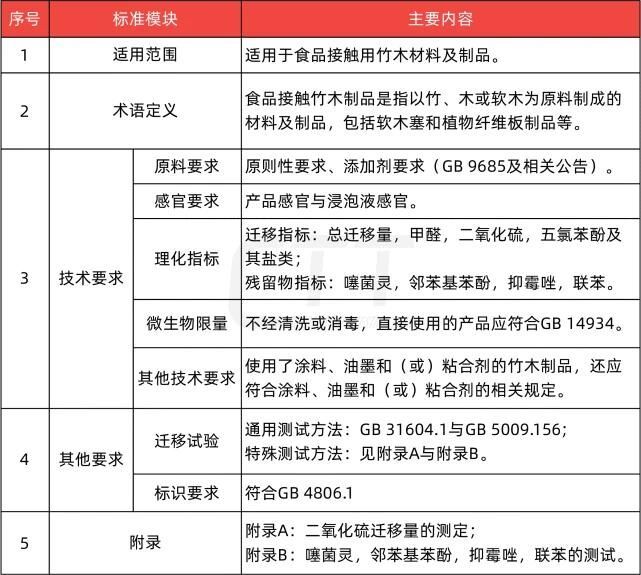On July 28, 2022, the National Health Commission, in accordance with the provisions of the Food Safety Law of the People's Republic of China, officially issued 36 national food safety standards, including the "National Food Safety Standard Food Additive Eugenol" (GB 1886.129-2022) and 3 amendments, after review and approval by the National Food Safety Standard Review Committee, including 3 relevant standards for food contact products.
The newly released food contact product standards are:
GB 4806.8-2022 National Food Safety Standard Food Contact Paper and Paperboard Materials and Products. This is the first revision of this product standard in six years and will be implemented on June 30, 2023.
GB 4806.12-2022 "National Food Safety Standard Food Contact Bamboo and Wood Materials and Products". The release of this standard will change the current situation where there has been a lack of relevant food safety standards for food contact bamboo and wood products, and will be implemented on December 30, 2022.
GB 31604.53-2022 National Food Safety Standard Food Contact Materials and Articles Determination of Migration of 5-Ethylene-2-norbornene. This standard is the test method standard for the migration of 5-ethylidene-2-norbornene and will be officially implemented on December 30, 2022.
The following highlights two new product standards :
GB 4806.8-2022 "National Food Safety Standard for Paper and Paperboard Materials and Products for Food Contact" is a revision of "National Food Safety Standard for Paper and Paperboard Materials and Products for Food Contact" (GB 4806.8-2016). The main changes to the standard are summarized in Table 1.
Table 1 Main revisions to GB 4806.8-2022
Analysis of important revisions
The consumption of potassium permanganate was deleted and chloropropanols, including 1,3-dichloro-2-propanol and 3-chloro-1,2-propanediol, were added .
This revision is based on experimental analysis results and cancels the potassium permanganate consumption index caused by lignin and total sugar in paper products. Based on the risk assessment results and combined with the actual situation of China's industry, the standard has added the residue limits of 1,3-dichloro-2-propanol (1,3-DCP) and 3-chloro-1,2-propanediol (3-MCPD) to effectively control their pollution; relevant manufacturers should strictly control the residues of chloropropanol in food contact paper and paperboard materials and products to ensure that they meet the limit requirements.
GB 4806.12-2022 "National Food Safety Standard for Food Contact Bamboo and Wood Materials and Products" is the first national food safety standard for food contact bamboo and wood products issued by my country. It will provide compliance requirements and control basis for the production and use of food contact bamboo and wood products in my country. The main contents of the standard are shown in Table 2 below.
Table 2 Main contents of GB 4806.12-2022
Introduction and interpretation of core projects
( 1) Sensory requirements:
The sensory requirements are normal color, no burrs, insect bites, odor, mildew or other dirt. The soaking liquid obtained from the migration test should not have deterioration of sensory properties such as precipitation, odor, abnormal coloration, etc. Among them, insect bites are not applicable to cork stoppers.
Risk Interpretation:
Considering that bamboo and wood products have their own unique natural color and smell, the sensory requirements clause requires that the soaking solution obtained from the migration test should not have abnormal coloring and odor, so as to distinguish it from the normal color and smell of bamboo and wood products presented in the extract.
( 2) Migrant indicators include:
Total migration amount ≤10mg/dm2
Formaldehyde ≤15mg/kg
Sulfur dioxide (water) ≤ 10mg/kg
· Pentachlorophenol and its salts (calculated as pentachlorophenol) ≤ 0.15 μg/kg
Risk Interpretation:
1) The total migration amount represents the total amount of all non-volatile substances that migrate out of food contact materials. If these non-volatile substances are excessively absorbed by the human body, they may cause harm to organs and the nervous system.
2) Bamboo and wood products for food contact are frequently used in daily life. In order to make them look beautiful, some manufacturers may use sulfur fumigation, hydrogen peroxide or sodium sulfate soaking and bleaching during the production process, resulting in the product containing a large amount of sulfur dioxide, which is leached into food through bamboo and wood products. It enters the human body through food or oral or skin contact and may cause gastrointestinal symptoms such as nausea and vomiting.
3) Formaldehyde and pentachlorophenol can be added to bamboo and wood products as preservatives during the production process. If the preservatives are not removed thoroughly, these substances will migrate into food during the use of bamboo and wood products in contact with food, and then enter the human body through food. After long-term accumulation or large-scale inhalation in the human body, it may cause disease.
( 3) Residue indicators include:
Thiabendazole ≤ 1.2 mg/kg
· o-phenylphenol ≤ 4.8 mg/kg
· Imazalil≤0.4mg/kg
Biphenyl ≤ 0.6 mg/kg
Risk Interpretation:
At present, the bactericides and mildew inhibitors that may be used on bamboo and wood products include thiabendazole, o-phenylphenol, imazalil, biphenyl, etc. After the bamboo and wood products are treated with bactericides and mildew inhibitors, the residual bactericides may migrate into food during the use of bamboo, wood and cork products, thereby endangering human health.
Kind tips
The newly released standards GB 4806.8-2022 and GB 4806.12-2022 will provide strong guidance for the production and processing companies of food contact bamboo and wood products and paper products to control product risks, and provide a basis for law enforcement for government regulatory authorities. They will play an important role in protecting consumer health, regulating corporate behavior, and maintaining a good market order.
Please leave us a message
Jinan Shengtai Electronic Technology Co., Ltd. is a high-tech enterprise specializing in the research, development, production and sales of new laboratory analytical instruments, online atmospheric monitoring equipment and laboratory intelligent pretreatment equipment.
Log in to view more information
Log in to view more information



